Introduction and the roots of type
Extraversion/Introversion (E/I)
Sensing/Intuition (S/N)
Thinking/Feeling (T/F)
Judging/Perceiving (J/P)
Doesn't type/temperament theory pigeonhole people into 16 "boxes"?
Here's a bit of an introduction to basic MBTI™. I'm not sure how much you know already so I'll just start from scratch. I've adapted this from an email I wrote to a friend.
MBTI™stands for Myers-Briggs Type Indicator™, which is basically a personality test and associated personality model based on the work of the Swiss psychologist Carl Gustav Jung (1875 - 1961). Jung was a contemporary of Austrian psychologist Sigmund Freud, and although Jung was initially a Freudian (and very highly regarded by Freud, who treated him like a son), a bitter disagreement erupted between the two and Jung split off to develop personality theories of his own.
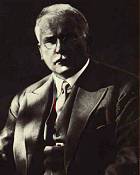
The legendary swiss doctor/psychologist Carl Gustav Jung; some say he was an INTP. |
Isabel Myers and Katheryn Briggs were a mother-and-daughter team of psychologists who took Jung's theory of psychological types (I believe work was started in the 1940s) and developed it into a basic type/temperament model that today is the Myers-Briggs Type Indicator™. Work and further research into type theory is continuing, and one of the most promising such developments is David Keirsey's "Temperaments" theory which treats the four letter functions not singly but in specific pairs (i.e. NT, NF, SJ and SP). Keirsey is most famous for his original type/temperament book, "Please Understand Me" (also known simply as PUM), which appeared in 1978 and which he co-authored with the late Marilyn Bates. PUM is by far the most universally well-known and best-selling of all type-related books, which is ironic as some purists consider Keirsey's temperament theory separate and distinct from the standard type theory model.
In type theory, there are 16 different personality "types," and each type has four letter slots, with each of these slots having one of two letters which describe the personality's preference in a particular area (so 24 = 16 basic personality types).
NOTE:MBTI™ and Myers-Briggs Type Indicator™ are trademarked names referring to a specific product, although brand confusion has resulted in the associated theory being referred to by names such as "personality typing," "type," or "type model," much as Kleenex™ has passed into common usage to refer to tissue paper. However, MBTI™ refers to the actual Myers-Briggs Type Indicator™ personality test, whereas "type" commonly refers to the theory behind it. "Temperament" refers to David Keirsey's temperament model, essentially an extension of type theory.
Extraversion/Introversion (E/I)
The first letter position can be either E or I, standing for Extraverted or Introverted. In a nutshell, this describes how we are "energised": extraverts recharge and get energised from lots of interaction with other people, while introverts need to spend time alone to recharge their internal batteries. Note that E or I does not necessarily have anything to do with "shyness" as such. There are plenty of introverts that easily pass as extraverts, except of course that they need to recharge their energies by spending time alone. The general public stereotype of introverts as pathological, reclusive and hermit-like is an inaccurate by-product of the glorious psychiatry days (remember the ice-pick lobotomies?). Some introverts are able to live happily isolated from people, while others (such as INFJs) regularly need to have people around to survive - these are the "affiliative introverts," a lighthearted label which some would say is a contradiction in terms!
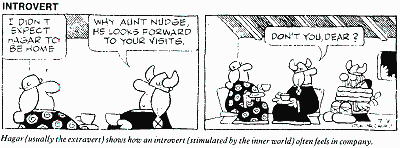
I think this is a rather shallow and inaccurate generalisation on introversion; many introverts aren't "bound up" but actually thrive on companionship and small gatherings of people, especially close friends. |
Sensing/Intuition (S/N)
The second letter can be either S or N, for Sensing or INtuitive (N for Intuitive since I has already been used for Introversion). This basically describes whether we are more observant (sensing) or introspective (intuitive). Sensates pay more attention to the outside world, the current surroundings and its immediate needs, whereas intuitives heed the promptings of the inner world of thoughts and feelings. Intuitives are more likely to have their heads in the future or the past, exploring possibilities and pathways - Ns typically like to daydream. Note that this is not to be mistaken for introversion. [This passage under review for technical inaccuracies.]
The public stereotype of the introvert would be an IN, an intuitive introvert with his or her head in the clouds, but in reality you can also get IS sensing introverts who have their attention focused firmly on the present. Also, it must be noted that in this instance intuition does not refer to psychic/paranormal type intuition, although in some instances it can. Studies suggest both S and N people can display psychic abilities, and rightly so.
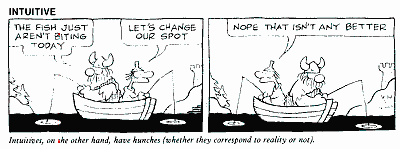
Intuitives love to explore the realm of possibilities! |
Thinking/Feeling (T/F)
The third letter indicates a preference for Thinking or Feeling. That is, whether our head or our heart rules us more. Contrary to popular belief, both thinking and feeling (in this context) are rational functions, used to make decisions and acting on them. A Feeling personality isn't illogical or irrational, despite what some may try to tell you! Feeling people cherish values more than principles -- so while they may follow rules, they will break them if it means helping somebody or being compassionate to others; the situation determines what the Feeler will do. Thinking types are more likely to stick to the principles and rules no matter what. They use logic to reach a conclusion and act on it.
Of course, things get much more complicated than that. The T and F functions are more than just decision-making processes, they determine how we come across and even what outlook we have on life. It's not uncommon for conflict to erupt between Ts and Fs. For example, an F person might accuse a T of being cold and unfeeling, insensitive, while the T might say that the F is weak-willed and mushy, unable to "think rationally." Ts and Fs have different value systems. Fs tend to be more compassionate, while Ts are usually firm.
One important point to note is that the T/F scale doesn't necessarily have anything to do with emotions. An F person could in theory appear to be relatively cold on the outside, whereas a T could seem bubbly and overemotional. When we are talking about T and F we are discussing the way people make decisions, not whether they seem emotional or not.
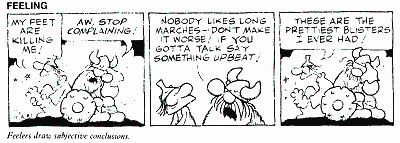
Feelers, like Lucky Eddie here, draw subjective conclusions based on their values. |
Judging/Perceiving (J/P)
Finally, fourth letter consists of either Judging or Perceiving, which determines how we run our lives. Perceivers prefer keeping their options open and would rather not be tied to a schedule. Note that this doesn't necessarily mean they are messy or disorganised people. With perceptive types, work doesn't have to be finished before play begins! Judgers are much more routine-oriented and orderly; they tend to have agendas, timetables, outlines, and so on. They would rather have closure than leave something unfinished, and prefer working towards a deadline. If they aren't on time, Js tend to get very nervous!
Note that Judging types aren't necessarily judgmental either - the two terms are unrelated; you can have judgmental Ps (in Type, a lot of the terms don't adhere to their "popular" definitions and hence are easily misunderstood).
Another interesting issue that has come up is whether Js tend to be tidier around the home than Ps, and the answer appears to be that tidiness doesn't seem to have much to do with Type. There are messy Js and tidy Ps. The main J/P difference appears to be closure - whether the person feels more at ease when an issue has been resolved or a task completed on time.
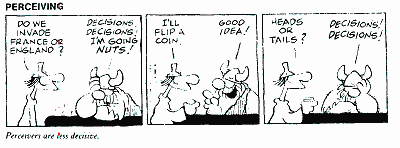
Perceivers often find it hard to reach a decision... |
Doesn't type/temperament theory pigeonhole people into 16 "boxes"?
Well, no it doesn't. The type model is a tool, and like all psychological tools it isn't perfect. The 16 basic personality types don't fully describe the rich and complex nature of human personalities, nor should they. Type merely attempts to describe and model people's behavioural and personality "preferences." Type is a valuable resource to aid us on our journeys of self-exploration, but it isn't the last word. In the end, only we can fully discover and understand ourselves.
Granted, not everybody wants to understand and discover more about themselves (and others), and I'm not in a position to speculate as to why. But I personally believe that a lot of positive change and progress could be achieved in this world if only everyone strove to better understand themselves and their differences.
"Seek first to understand, and then to be understood."
Steven Covey
